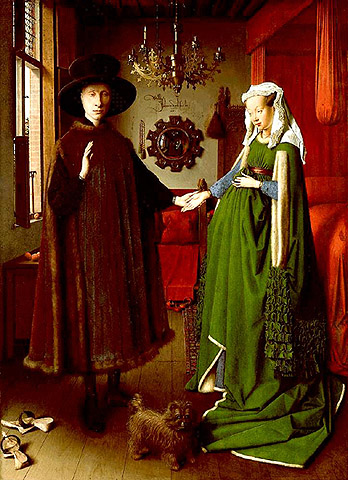This is a rather famous painting by Jan van Eyck. You've probably see it or a parody of it before. It is a portrait of a wealthy merchant and his wife/bride (there's some debate about that) named Arnolfini. It is currently held in the National Gallery in London.

Here's a close-up of the mirror and beads between the couple in the background.

It was painted in 1434 and the original measures 82x60cm--tiny for having so much detail. Back in the 1400s paintings presented viewers with a piece of magic, a representation of their world that they could never have had otherwise. It was all about detail, symbolic meaning, and beautiful, flat, luminous paint. You'll have a hard time finding brushstrokes in this image, and that was part of the fun. The medium hides beneath the depictions.
Contrast that with the work of Rembrandt, 200 years later. This is a self portrait of his from 1669:

Click on it to get a bigger, better representation. Rembrandt left his footprint in the form of brush strokes. During the same time in Spain, Velazquez was painting in a similar style. Here you can see a close up of a little Spanish princess, whose dress is rendered so loosely that you could argue for the advent of impressionism 300 years early.
Of course, nobody left traces of themselves in painting to the degree that the abstract-expressionist, action painters, or oxidation artists did, but that’s for another day.

No comments:
Post a Comment